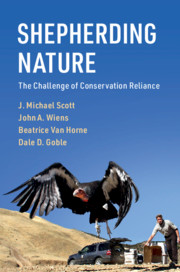Book contents
- Shepherding Nature
- Shepherding Nature
- Copyright page
- Contents
- Preface
- Acknowledgments
- 1 Extinction and the Challenge of Conservation Reliance
- 2 The Conservation Spectrum
- 3 The Genesis of Conservation Reliance and the Language of Conservation
- 4 What Are the Threats?
- 5 Emerging Threats in a Rapidly Changing World
- 6 The Role of Policy and Law
- 7 What’s in the Conservationist’s Toolbox: Species-Centered Approaches
- 8 Expanding the Conservationist’s Toolbox: Going Beyond Species
- 9 Conservation Reliance Is a Human Issue
- 10 Making Tough Decisions: Prioritizing Species for Conservation
- 11 Being a Good Shepherd
- Book part
- Essay Contributors
- References
- Index
10 - Making Tough Decisions: Prioritizing Species for Conservation
Published online by Cambridge University Press: 28 February 2020
- Shepherding Nature
- Shepherding Nature
- Copyright page
- Contents
- Preface
- Acknowledgments
- 1 Extinction and the Challenge of Conservation Reliance
- 2 The Conservation Spectrum
- 3 The Genesis of Conservation Reliance and the Language of Conservation
- 4 What Are the Threats?
- 5 Emerging Threats in a Rapidly Changing World
- 6 The Role of Policy and Law
- 7 What’s in the Conservationist’s Toolbox: Species-Centered Approaches
- 8 Expanding the Conservationist’s Toolbox: Going Beyond Species
- 9 Conservation Reliance Is a Human Issue
- 10 Making Tough Decisions: Prioritizing Species for Conservation
- 11 Being a Good Shepherd
- Book part
- Essay Contributors
- References
- Index
Summary
Current methods for making decisions about what to fund and at what level are not sufficiently transparent or objective. Acknowledging conservation reliance fosters a realistic approach and outcomes. Prioritization requires an agreed-upon pool of species to consider within a defined area. Defining and ranking prioritization criteria presents a variety of challenges, including accounting for the manageability of threats, species vulnerability, and species genetic and phenotypic traits. Including social and economic factors increases the probability that plans will be implemented. This chapter also considers how factor weightings are derived and means of dealing with uncertainty. Four examples of prioritization processes illustrate the variety of current approaches. Few approaches explicitly consider the long-term demands of conservation reliance. The ethics that underlie conservation triage affect how people undertake prioritization. This book advocates the use of explicit prioritization criteria that include uncertainties and derive from values and interests of diverse stakeholders. Models should acknowledge a wide array of ecological and socioeconomic costs and benefits, probabilities of success, and projected conservation reliance.
Keywords
- Type
- Chapter
- Information
- Shepherding NatureThe Challenge of Conservation Reliance, pp. 291 - 317Publisher: Cambridge University PressPrint publication year: 2020

